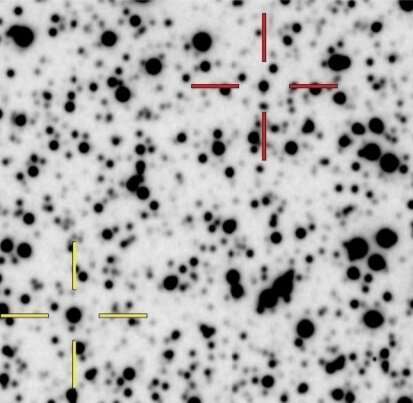November 15, 2021 report
J1832.4-1627 is the first eclipsing stream-fed intermediate polar, study finds

German astronomers have conducted photometric observations of a recently discovered polar known as J1832.4-1627. This object is the first deeply eclipsing stream-fed intermediate polar so far detected. The study was detailed in a paper published November 4 on arXiv.org.
Cataclysmic variables (CVs) are binary star systems consisting of a white dwarf accreting material from a normal star companion. They irregularly increase in brightness by a large factor, then drop back down to a quiescent state. Polars are a subclass of cataclysmic variables distinguished from other CVs by the presence of a very strong magnetic field in their white dwarfs.
In some CVs, accretion occurs through a truncated accretion disk when the white dwarf is moderately magnetic. These systems are known as intermediate polars (IPs). Observations have shown that in IPs, the magnetic white dwarf spins asynchronously with the orbital period of the system and therefore produces a rapid oscillation with the spin period.
Astronomers hypothesize that some IPs might have a freely spinning white dwarf with a sufficiently strong magnetic moment to avoid the formation of a disk and accrete instead from a stream that alternately feeds its two poles, a situation referred to as pole flipping. However, no stream-fed IP has yet been found.
Now, a group of researchers led by Klaus Beuermann of the University of Göttingen in Germany reports that J1832.4-1627 (J1832 for short), located between 4,100 and 9,300 light years away from the Earth, is such a stream-fed intermediate polar. The eclipsing IP J1832 was discovered in July 2019 by Erwin Schwab using the 80-cm Schmidt telescope of the German-Spanish Astronomical Center at Calar Alto, Spain.
J1832 has an orbital period of approximately 8.87 hours and showcases a coherent large-amplitude 65-minute pulsation, what confirms that it is an intermediate polar. It showed no evidence for an accretion disk in three consecutive observing seasons, suggesting that this is a long-lasting feature.
The astronomers found that the eclipsed light of J1832 originates almost entirely from the two accretion spots and columns on the white dwarf, with characteristics indicative of pole flipping. They emphasized that the lack of a luminous disk and the observed stream flipping in J1832 are not short-lived transitory phenomena, what supports the hypothesis that this object is a deeply eclipsing stream-fed IP.
"The evidence for the stream flipping is based on the pulse phase dependence of the eclipse centers and the orbital phase dependence of the pulse minima observed in all three observing seasons. These results strongly suggest that J1832 is stream-fed," the researchers explained.
The authors of the paper added that J1832 exhibits a variable accretion rate and lapses repeatedly into short-lived low states of negligible accretion. Moreover, its orbital period appears to be decreasing. Further studies, especially X-ray observations, optical spectroscopy, and spectropolarimetry are required in order to better understand such behavior of this polar.
More information: K. Beuermann et al, J1832.4-1627, the first eclipsing stream-fed intermediate polar. arXiv:2111.02752v1 [astro-ph.SR], arxiv.org/abs/2111.02752
© 2021 Science X Network




















